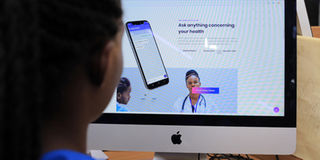When your doctor is just a click away

Through telemedicine, you can chat with a doctor using your phone or computer. A diagnosis is made and prescription written and if there is need to see a doctor, an appointment is made. PHOTO BY RACHEL MABALA
What you need to know:
- Truth be told, a number of things put us off from going to hospital. For example, having to wait for hours to see a doctor when you have a throbbing headache. With Telemedicine, doctors are trying to make it easier by diagnosing and giving prescriptions online. We look at how this works.
Technology advancement has revolutionalised our lives from the way we communicate, to how we transact business and lately how we take care of our health. Traditionally, when an individual is not feeling well, they go to a medical facility where they wait and see a doctor, if they are fortunate.
More than a decade ago, getting quality, fast and personalised medical attention was a rarity reserved for the wealthy and powerful. However, nowadays, with the advancement of telemedicine, anyone with a smartphone and Internet connection can access a doctor for diagnosis, monitoring, and feedback at home.
Telemedicine in Uganda
Dr Raymon Baluku, the director of Seven, a doctor-patient online medical platform says use of technologies for healthcare management has been associated with reductions in hospitalisations, readmissions, length of stay, cost, high rates of satisfaction and better adherence to medication.
“I was inspired to venture into telemedicine out of frustration. Four years ago, while working at Kabale Referral Hospital, I had a two-year old patient who needed to see a hematologist urgently. This became a dilemma since the closest hematologist was at Mbarara Regional Referral Hospital. Her parents had to travel there to get an appointment. It transpired that the doctor was not available and they were referred to Mulago National Referral Hospital in Kampala. All this was frustrating and I started looking for ways to bridge that gap thus the birth of Seven,” Baluku relates.
Like many applications of its kind, Seven helps patients get instant diagnosis and a complete medical report you can print out and take to a pharmacy to get drugs, thereby getting treatment faster and conveniently.
Doubtful if a doctor can give the right diagnosis from a live chat with a patient, Dr Baluku says up to 70 per cent of the diagnosis is usually got from history taking.
“For instance, if you have a cough or food poisoning, I will ask the same questions the doctor will ask you if you were in the same room. It is when the symptoms are not so specific that we decide to do further tests. So, I am confident that we can treat 70 per cent of the patients that use our app. Then, the 30 per cent cases that cannot be handled online are referred to the nearest doctor,” Dr Baluku reveals.
Fight self-medication
By availing a quick and accurate diagnosis the doctor hopes it will fight against self-medication and the use of “doctor Google”.
“It is scary what happens when someone searches the Internet with an ailment looking for treatment. The search engine will give a multitude of diagnosis leaving you stressed and facing the difficult task of deciding on which ailment you actually have,” he notes.
Dr Steven Baguma notes that telemedicine has reduced avoidable visits to emergency departments for both medical personnel and the patients. The biggest benefit of telehealth is the ability to provide immediate access to care that otherwise would be difficult to obtain. Rural communities, for example here in Uganda, lack the healthcare infrastructure of more densely populated areas.
Distance
Often, rural patients need to drive for hours to see a practitioner, which is not always practical or possible. Telehealth creates an alternative way for patients and practitioners to remain in contact between appointments or for patients to have visits with specialists that they would ordinarily not be able to.
“Take for instance people living in rural areas where there are neither medical facilities nor physicians, often resort to herbalists or communal diagnosis. But with a smartphone, they are able to get medical attention urgently,” he explains. It also reduces the rate of readmission thus improving the quality of health care.
Mental illness
“Physicians are able to do frequent follow up with their patients compared to traditional visits. On the other hand, patients are able to inform their doctors immediately they feel something is wrong, which can reduce false urgent care visit and sometimes save a life before things get worse,” he reveals.
Another field that has largely benefited from telemedicine according to Dr Baguma is the care of chronic and mental illnesses.
“Mental illness is becoming a source of great concern and fixing the problem will require redifining healthcare to include behavioural health, moving beyond the stigma so people feel comfortable seeking care, and coming together of multiple stakeholders and experts to develop new ways to deliver that care, he notes adding that with good telemedicine software, you do not need to do the traditional face-to-face therapy, which patients find inconveniencing and stressful," he says.
Access
In some cases, time is running against a patients, and doctors need to get a second opinion from another specialist. Using telemedicine software, doctors can quickly establish a secured video call to get a second opinion saving the patient’s life.
According to Dr Andrew Patrick Tamale, telemedicine has quickly become popular in Uganda because the secret is not in the technology itself, but the way physicians treat and care for their patients. Having a doctor on your phone kind of breaks down the barriers and creates a bond.




